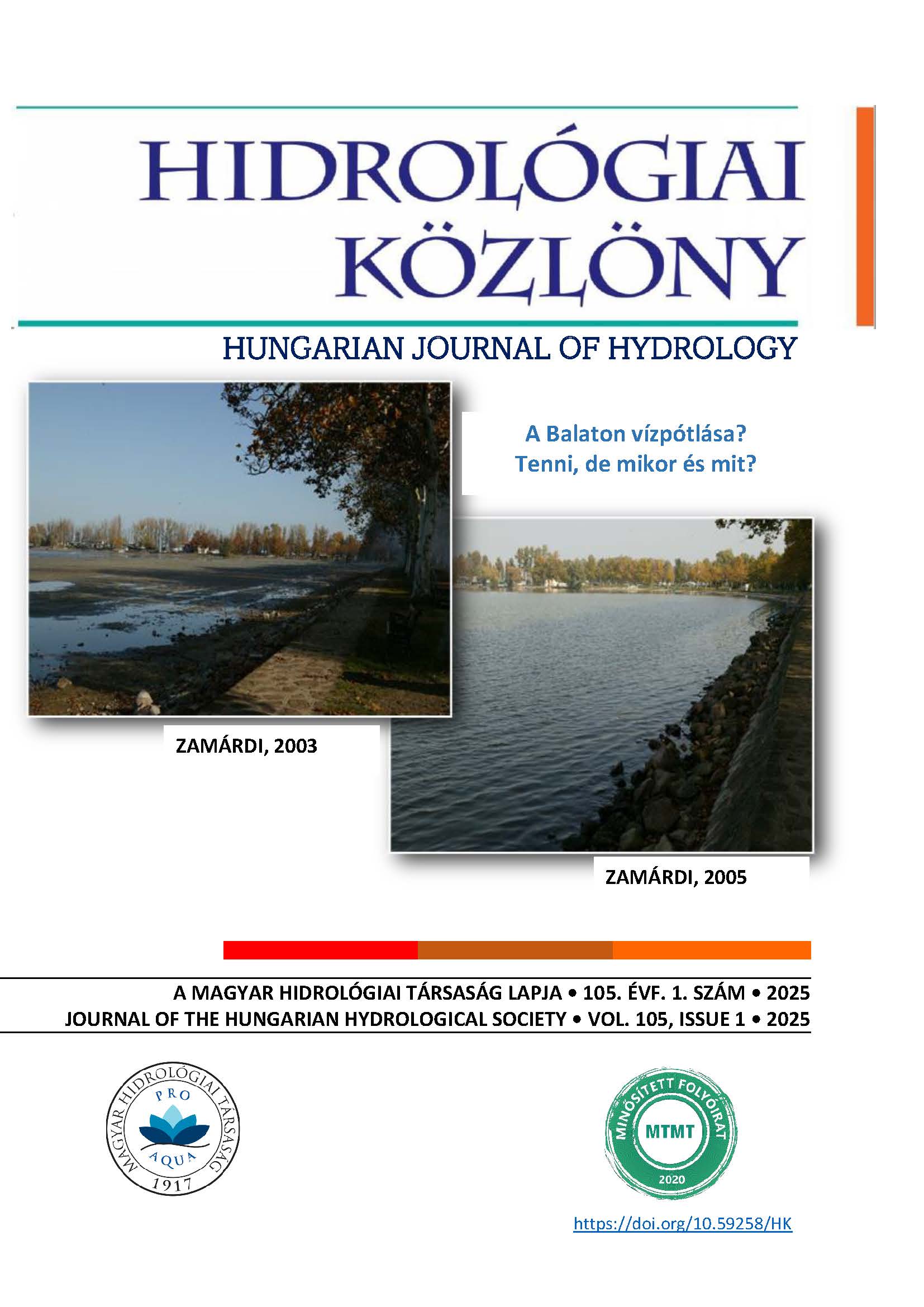A Hévízi-tó monitoring hálózata, annak fejlesztése, kiegészítése kampányjellegű mérésekkel
Absztrakt
A Hévízi-tó és környezete a magyarországi fürdőkultúra és turizmus emblematikus helye. Ezzel összefüggésben vált a hazai karsztkutatás egyik legfontosabb helyszínévé. Jelen tanulmány röviden felsorakoztatja a Hévízi-tóval kapcsolatos évszázados múltra visszatekintő kutatásokat, majd pedig azt kívánja összefoglalni, hogy napjainkban ezeket a korábbi tapasztalatokat, feltételezéseket milyen általunk végzett mérésekkel, vizsgálatokkal bővítjük ki. Ehhez szükségszerűen megjelenik a jelenleg üzemeltetett monitoring rendszer felépítése, amelyet saját fejlesztésű műszerekkel egészítettünk ki. Mindezek mellett bemutatjuk a kampányjellegű méréssorozatokat is, amelyek célja az évtizedek során megváltozott felszíni és felszín alatti áramlási viszonyok megismerése, valamint hidrometeorológiai mérésekkel a tó párolgásának, hőháztartásának és ezek kombinálásával a vízmérlegének meghatározása.
Hivatkozások
/2023. (XI. 20.) Korm. rendelet a közhasználatú fürdők létesítéséről és üzemeltetéséről
Böcker T. (1975a). A nyirádi víztelenítés hatásának vizsgálata, különös tekintettel a Hévízi-tóforrásra. – VITUKI témabeszámoló III. 3.3.3.4.
Böcker T. (1975b). Változások a Dunántúli-középhegység természetes karsztvízháztartásában. VITUKI 1975. évi Tudományos Napok 2. ülésszak: A szénbányászattal kapcsolatoskarsztvíz kérdések. 11 p.
Böcker T. (1978). Összefoglaló jelentés a hévízi tóval kapcsolatos kutatási tevekénységről. V1TUKI 7631/1/4, Budapest, 1978.
Böcker T., Liebe P., Hőriszt Gy. (1986). A Hévízi-tó és a közvetlen környezetének állapota 1985-ben. Földtani Kutatás XXIX. évfolyam (4), pp. 71-83.
Cholnoky J. (1918). A Balaton hidrografiája, A Balaton tudományos tanulmányozásának eredményei. Budapest 1908 I. (2) függelék: pp 1-311.
Cziráky J. (1954). A hévízi tó forráskráterének búváros vizsgálata. Hidrológiai Közlöny. 1954/5-6.
Cziráky J. (1957). Felszíni áramlás vizsgálatok a hévízi tavon. Hidrológiai Közlöny. 1957/4.
Csepregi A. (2007). A karsztvíztermelés hatása a Dunántúli-középhegység vízháztartására – In: Alföldi, L.– Kapolyi, L. (szerk.): Bányászati karsztvízszint-süllyesztés a Dunántúli-középhegységben. Requiem a Dunántúli-középhegység karsztvízszint alatti bányászkodásáért. MTA Földrajztudományi Kutatóintézet, Budapest. pp. 77-106.
Fujita I., Muste M., Kruger A. (1998). Large-scale particle image velocimetry for flow analysis in hydraulic engineering applications. Journal of Hydraulic Research 36. pp. 397-414. https://doi.org/10.1080/00221689809498626
Gorzó Gy. (1990). A Hévízi-tó vízminőségének változása. Hidrológiai Közlöny 1990. 70. évf. 1. szám, pp 12-16.
Haszpra O. (1985). Kémény a hévízi-tóban. Élet és Tudomány 40 (7), pp. 195-196.
Hencz A. (1891). A hévízi forrás. Keszthelyi Hírlap, pp 16.
Horányi Á., Sugár I. (1975). Vizsgálatok a Hévízi-tó utánpótlódási viszonyairól. Vízgazdálkodási Tudományos Kutató Intézet, Tudományos Szemle 1 (1), pp. 68-77.
Kádár I. (1972). Hévízi tó múltja, jelene és jövője. Hévízi tókutatása TV-s kamerával. Kézirat, Budapest, 5 p.
Kugler Gy. (1986). Hévízi-tó vízhozam szabályozása. Diplomaterv. Budapest Műszaki Egyetem, Vízgazdálkodási és Vízépítési Intézet, Vízépítési Tanszék
Lóczy L. (1908). Jegyzet Jordán Károly: A Hévízi tó fenekének fölmérése c. cikkéhez. A Balaton tudományos tanulmányozásának eredményei. Budapest 1908 II. (2). p 78.
Lorberer Á. (1979). Regionális vízföldtani vizsgálatok a Hévízi-tótágabb környezetében. VITUKI III. C. 5. pp. 1-19.
Moll K. (1941). A hévízfürdői tó hőmérsékleti vizsgálata. Hidrológiai Közlöny, 21. évf. 1-6. kötet, pp 1-14.
Muste, M., Fujita, I., Hauet, A. (2008). Large-scale particle image velocimetry for measurements in river environments. Water Resources Research 46:2008WR006950, p. 14. https://doi.org/10.1029/2008WR006950
Müller P. (1975). Újabb adatok a Keszthelyi-hegység és a Hévízi-tó hidrogeológiájához. Beszámoló a Magyar Karszt- és Barlangkutató Társulat tevékenységéről 1975 (2), pp. 153-154.
Plózer I. (1976a). Az Amphora Könnyűbúvár Sport Club Vízalatti Barlangkutató Csoportjának 1976. évi jelentése. — Beszámoló a Magyar Karszt- és Barlangkutató Társulat 1976. évi tevékenységéről, Budapest, pp. 260-264.
Plózer I. (1976b). A Vízalatti Barlangkutató Szakosztály 1976. évi jelentése. Beszámoló a Magyar Karszt és Barlangkutató Társulat 1976 évi tevékenységéről, Budapest, pp. 58-59.
Plózer I. (1977). A Hévízi-tó forrásbarlangjának feltárása. Karszt és Barlang (1-2), pp. 65-66.
Reska Zs. (2024). A Hévízi-tó háromdimenziós digitális ikrének fejlesztése. Szakdolgozat. BME Építőmérnöki Kar, Fotogrammetria és Térinformatika Tanszék.
Sárváry I. (1991). A Hévízi-tó utánpótlódásának kérdései. Hidrológiai Közlöny 71. évf. 1. szám, pp. 8-20.
Sas D. (2024). Áramlásirány-mérő műszer fejlesztése és tesztelése. Szakdolgozat. BME Vegyész- és Biomérnöki Kar, Szervetlen és Analitikai Kémia Tanszék.
Solt P. (2015). Az Amphora Búvár Klub kutatásai a Hévízi-tóban (Plózer István kutatóbúvár emlékére). A Magyar Földtani és Geofizikai Intézet Évi Jelentése, 2014-2015, pp. 131-142.
Starosolszky Ö. (1984). A Hévízi tó belső áramlásai. Hidrológiai Közlöny, 1984. 5. sz. pp. 323-332.
Szádeczky-Kardoss E. (1941). A Keszthelyi-hegység és a Hévíz hidrológiájáról. Hidrológiai Közlöny. 21. évfolyam, 1-6 kötet, pp. 15-28.
Szántó E. (1993). Hévíz. Nereus Kiadói Bt.
Székely E. (2022). „A Dunántúli-Középhegységi karsztvízszint-emelkedés okozta jelenségek állapotrögzítése, a várható emelkedés modellezése” projekt keretében készült Hévíz-Keszthelyi-Hegység lokális modell ismertetése a Smaragd-GSH Kft. jelentése alapján. Nyugat vizei. A Nyugat-Dunántúli Vízügyi Igazgatóság hivatalos lapja, 4. évf. 1. szám pp. 4-8.
Torma P., Reska Zs., Nagy J.B., Hajnal G., Rehák A. (2024). Analyzing the turbulent air-water fluxes and the energy balance of a geothermal lake. IAGLR 67. éves Konferenciája, Windsor, Kanada, 2024. május 20-24.
Tóth Gy. (2017). A Hévízi-tó vízgazdálkodási helyzete előadás. Balatoni Részvízgyűjtő Vízgazdálkodási Tanács ülése
Ugray K. (1953). Kiemelkedő búvárteljesítmények. Búvárismeretek, Közlekedési Kiadó, Budapest, pp. 144.
Weszelszky Gy. (1908). A Hévíz tó chemiai vizsgálatának előzetes eredményei. A Balaton tudományos tanulmányozásának eredményei. Budapest 1908 II. (2). pp. 80-82.
Weszelszky Gy. (1911). A keszthelyi Hévízi tó termékeinek chemiai vizsgálata. A Balaton tudományos tanulmányozásának eredményei. Budapest 1911 I. (6) függelék. pp. 1-20.
Windisch R. (1911). Jelentés a Hévízi vízvizsgálatokról. A Balaton tudományos tanulmányozásának eredményei. Budapest 1911 I. (6) függelék. pp. 21-24.
https://termalonline.hu/termal-hirek/kiderult-milyen-eve-volt-a-hevizi-tofurdonek#google_vignette (Utolsó letöltés: 2024.09.13.)
Copyright (c) 2025 Judit Barbara Nagy , Géza Hajnal , Dénes Szieberth , András Miklós Rehák, Zsombor János Reska

This work is licensed under a Creative Commons Attribution-NonCommercial-ShareAlike 4.0 International License.




